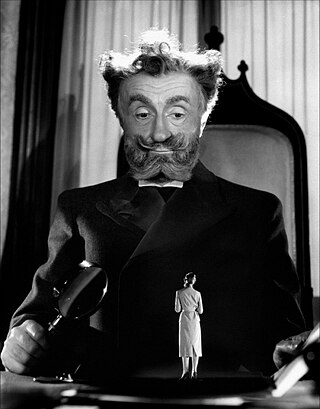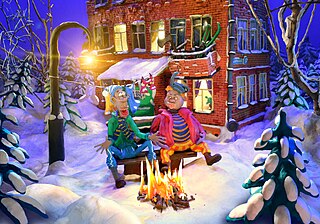
Animation is a method by which still figures are manipulated to appear as moving images. In traditional animation, images are drawn or painted by hand on transparent celluloid sheets to be photographed and exhibited on film. Today, many animations are made with computer-generated imagery (CGI). Computer animation can be very detailed 3D animation, while 2D computer animation can be used for stylistic reasons, low bandwidth, or faster real-time renderings. Other common animation methods apply a stop motion technique to two- and three-dimensional objects like paper cutouts, puppets, or clay figures.

Computer animation is the process used for digitally generating animations. The more general term computer-generated imagery (CGI) encompasses both static scenes and dynamic images, while computer animation only refers to moving images. Modern computer animation usually uses 3D computer graphics to generate a three-dimensional picture. The target of the animation is sometimes the computer itself, while other times it is film.

Stop motion is an animated filmmaking technique in which objects are physically manipulated in small increments between individually photographed frames so that they will appear to exhibit independent motion or change when the series of frames is played back. Any kind of object can thus be animated, but puppets with movable joints or plasticine figures are most commonly used. Puppets, models or clay figures built around an armature are used in model animation. Stop motion with live actors is often referred to as pixilation. Stop motion of flat materials such as paper, fabrics or photographs is usually called cutout animation.

A zoetrope is one of several pre-film animation devices that produce the illusion of motion by displaying a sequence of drawings or photographs showing progressive phases of that motion. It was basically a cylindrical variation of the phénakisticope, suggested almost immediately after the stroboscopic discs were introduced in 1833. The definitive version, with easily replaceable picture strips, was introduced as a toy by Milton Bradley in 1866 and became very successful.

Special effects are illusions or visual tricks used in the theatre, film, television, video game, amusement park and simulator industries to simulate the imagined events in a story or virtual world.
While the history of animation began much earlier, this article is concerned with the development of the medium after the emergence of celluloid film in 1888, as produced for theatrical screenings, television and (non-interactive) home entertainment.
Visual effects is the process by which imagery is created or manipulated outside the context of a live-action shot in filmmaking and video production. The integration of live-action footage and other live-action footage or CGI elements to create realistic imagery is called VFX.

Clay animation or claymation, sometimes plasticine animation, is one of many forms of stop-motion animation. Each animated piece, either character or background, is "deformable"—made of a malleable substance, usually plasticine clay.

Traditional animation is an animation technique in which each frame is drawn by hand. The technique was the dominant form of animation in cinema until computer animation.

Cutout animation is a form of stop-motion animation using flat characters, props and backgrounds cut from materials such as paper, card, stiff fabric or photographs. The props would be cut out and used as puppets for stop motion. The world's earliest known animated feature films were cutout animations, as is the world's earliest surviving animated feature Die Abenteuer des Prinzen Achmed (1926) by Lotte Reiniger.

Ragdoll physics is a type of procedural animation used by physics engines, which is often used as a replacement for traditional static death animations in video games and animated films. As computers increased in power, it became possible to do limited real-time physical simulations, which made death animations more realistic.
Go motion is a variation of stop motion animation which incorporates motion blur into each frame involving motion. It was co-developed by Industrial Light & Magic and Phil Tippett. Stop motion animation can create a distinctive and disorienting staccato effect because the animated object is perfectly sharp in every frame, since each frame is shot with the object perfectly still. Real moving objects in similar scenes have motion blur because they move while the camera's shutter is open. Filmmakers use a variety of techniques to simulate motion blur, such as moving the model slightly during the exposure of each film frame, or placing a glass plate smeared with petroleum jelly in front of the camera lens to blur the moving areas.
David W. Allen was an American film and television stop motion model (puppet) animator.

Precursors of film are concepts and devices that have much in common with the later art and techniques of cinema.
Digital puppetry is the manipulation and performance of digitally animated 2D or 3D figures and objects in a virtual environment that are rendered in real time by computers. It is most commonly used in filmmaking and television production, but has also been used in interactive theme park attractions and live theatre.
The history of animation in the United Kingdom began at the very origins of the artform in the late 19th century. British animation has been strengthened by an influx of émigrés to the UK; renowned animators such as Lotte Reiniger (Germany), John Halas (Hungary), George Dunning and Richard Williams (Canada), Terry Gilliam and Tim Burton have all worked in the UK at various stages of their careers. Notable full-length animated features to be produced in the UK include Animal Farm (1954), Yellow Submarine (1968), Watership Down (1978), and Wallace & Gromit: The Curse of the Were-Rabbit (2005).
The history of computer animation began as early as the 1940s and 1950s, when people began to experiment with computer graphics – most notably by John Whitney. It was only by the early 1960s when digital computers had become widely established, that new avenues for innovative computer graphics blossomed. Initially, uses were mainly for scientific, engineering and other research purposes, but artistic experimentation began to make its appearance by the mid-1960s – most notably by Dr Thomas Calvert. By the mid-1970s, many such efforts were beginning to enter into public media. Much computer graphics at this time involved 2-dimensional imagery, though increasingly as computer power improved, efforts to achieve 3-dimensional realism became the emphasis. By the late 1980s, photo-realistic 3D was beginning to appear in film movies, and by mid-1990s had developed to the point where 3D animation could be used for entire feature film production.

Computer-generated imagery (CGI) is a specific technology or application of computer graphics for creating or improving images in art, printed media, simulators, videos and video games. These images are either static or dynamic. CGI both refers to 2D computer graphics and 3D computer graphics with the purpose of designing characters, virtual worlds, or scenes and special effects. The application of CGI for creating/improving animations is called computer animation, or CGI animation.
A live-action animated film is a film that combines live action filmmaking with animation. Films that are both live-action and computer-animated tend to have fictional characters or figures represented and characterized by cast members through motion capture and then animated and modeled by animators. Films that are live action and traditionally animated use hand-drawn, computer-generated imagery (CGI) or stop motion animation.
Puppet film develops on the basis of traditional puppetry. It is in the form of a film that the main characters are puppets. Puppets’ limbs are controlled by people and their mouths usually does not move frequently. The height of a puppet is approximately 20 centimeters and the background is a model which fits the size of the puppet. The film is shot by grid-by-frame photography. Puppet film starts around 1900s. Between 1930s and 1980s, most genres of puppet films are comedy and animation. There are some famous magnum opus such as Thunderbirds series and The Adventures of Elmo in Grouchland. After 1980s, many horror puppet films appeared such as Puppet Master: The Littlest Reich. Compared to other films, puppet film focuses more on characters’ movements and the main audiences are children and teenagers. More and more reality elements are added into puppet film in recent years.










